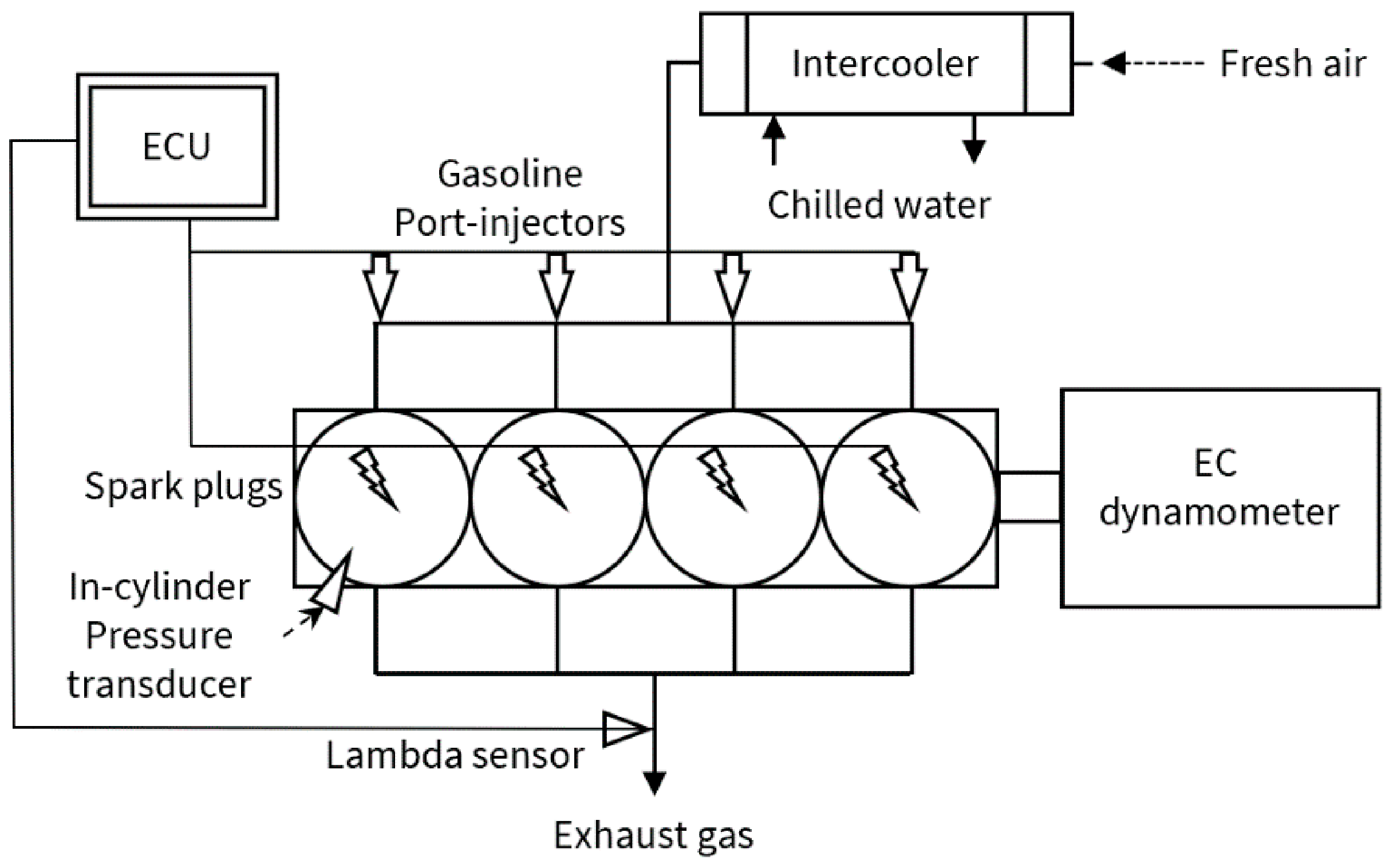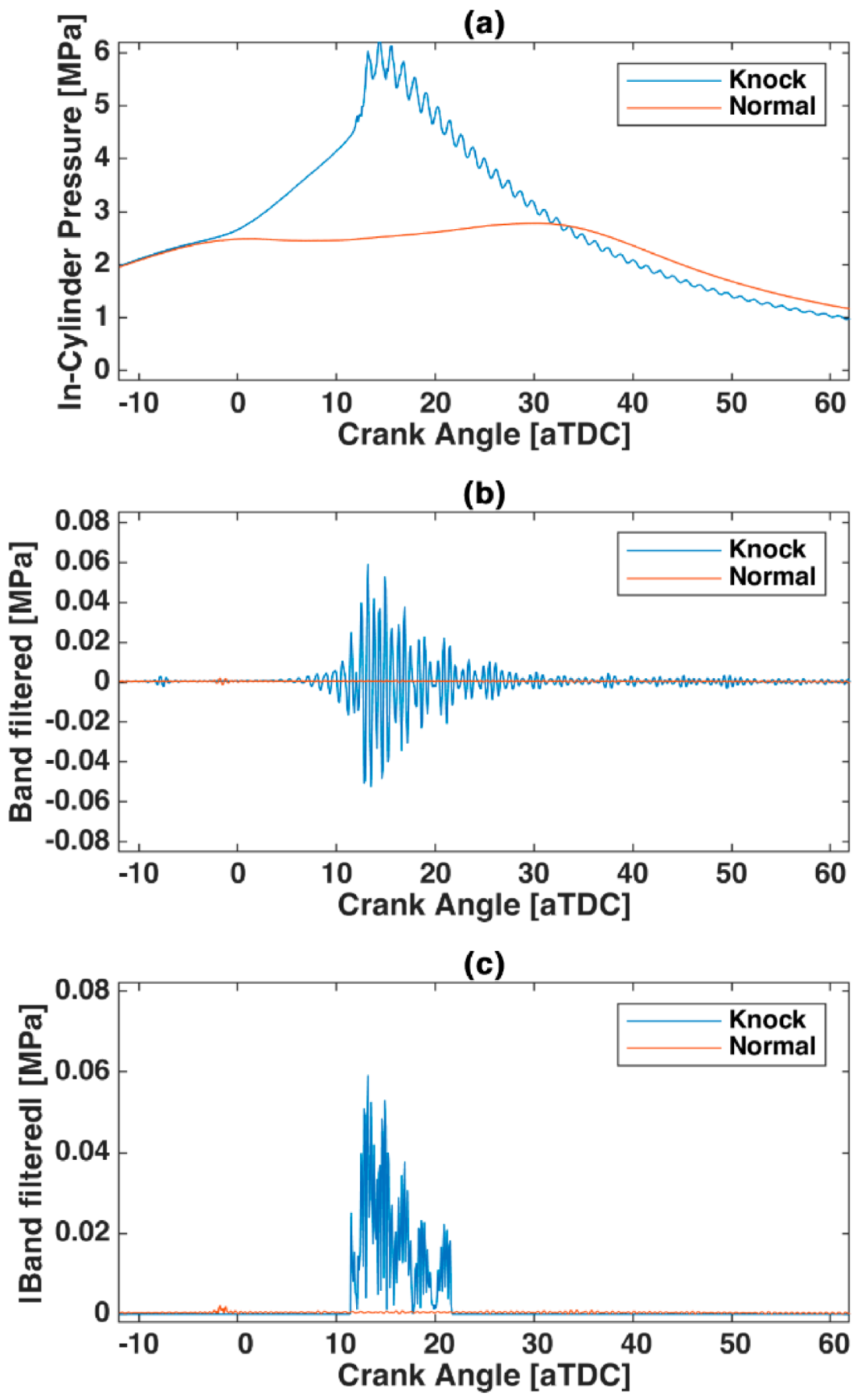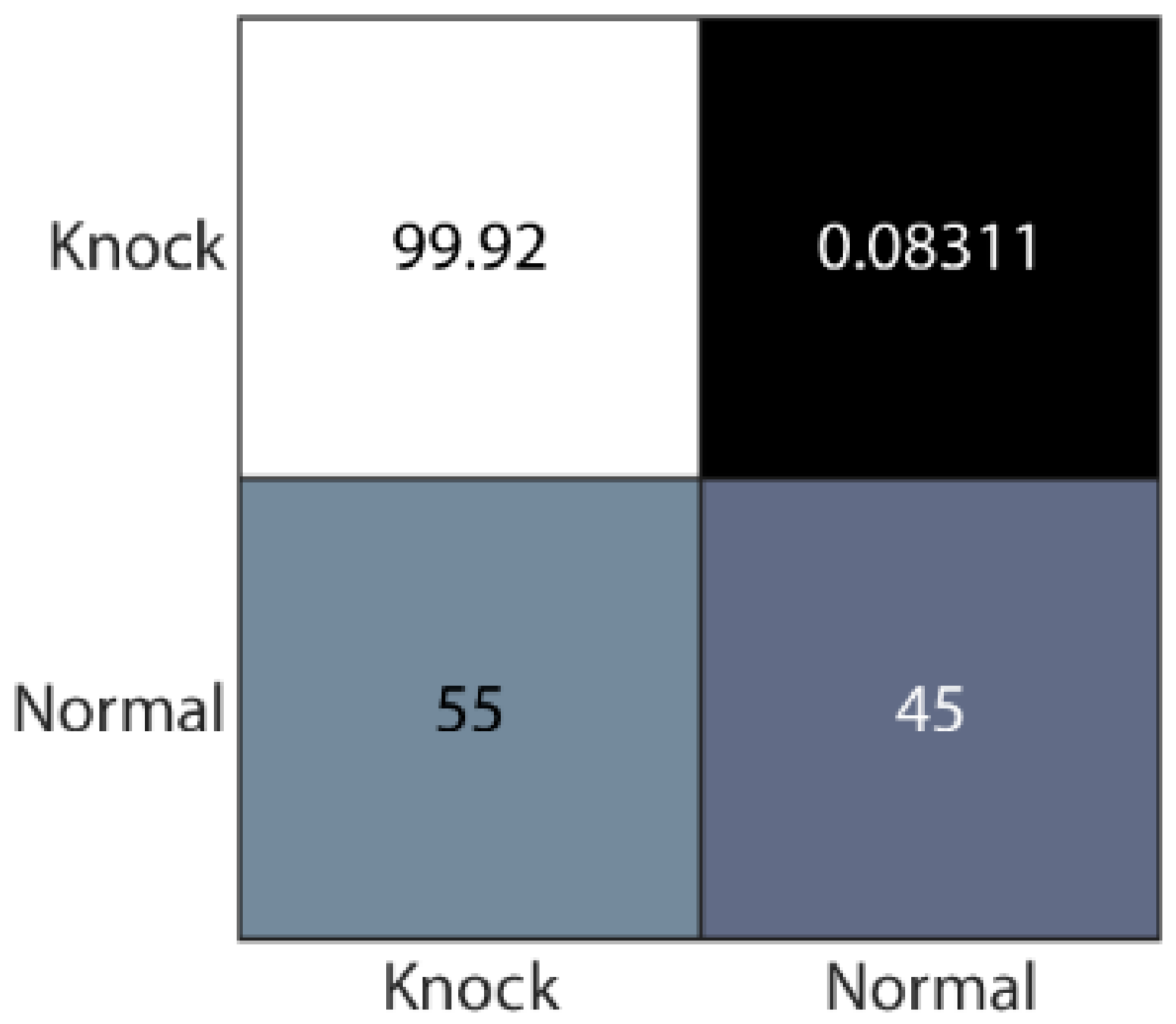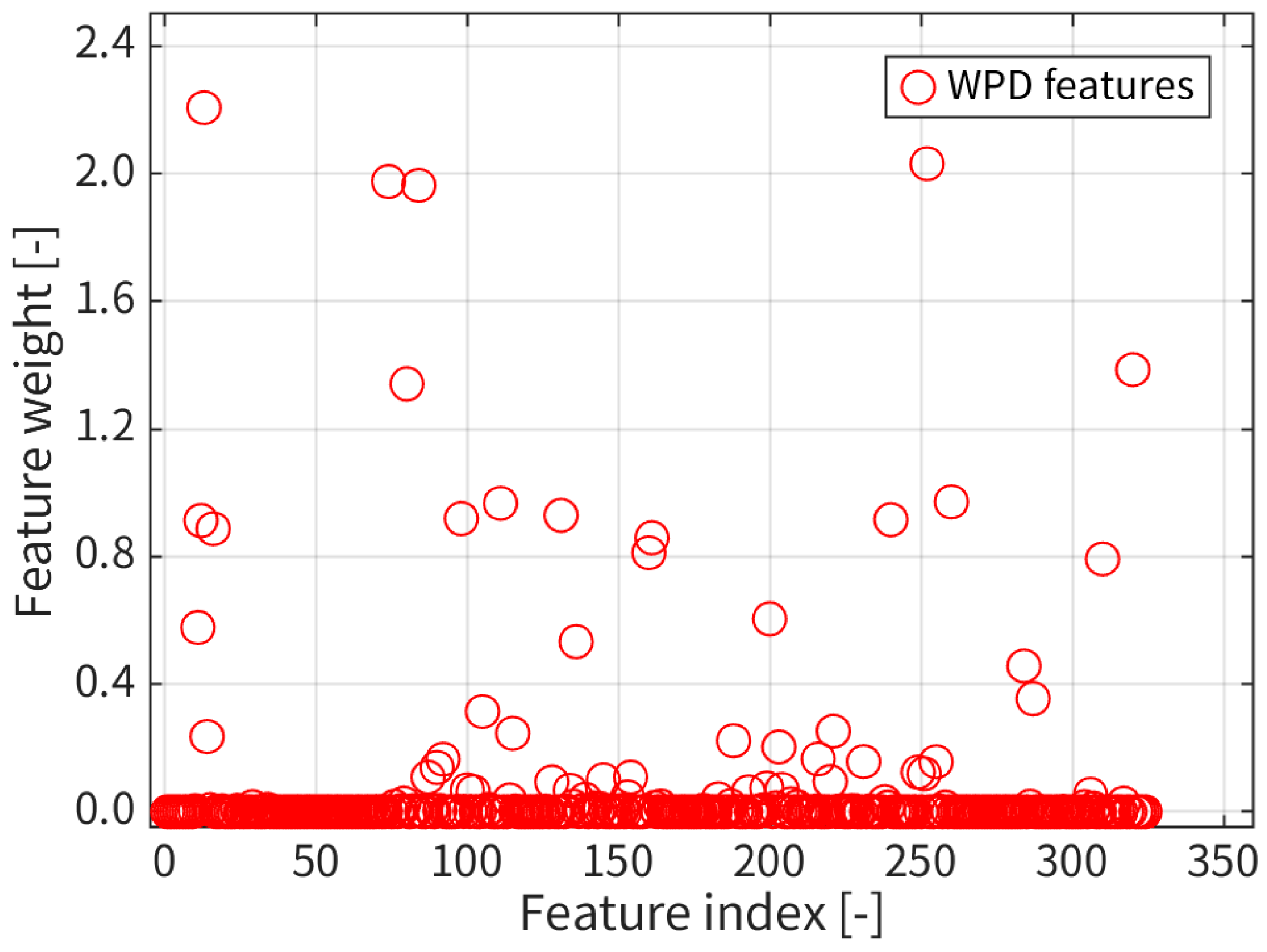1. Introduction
Knocking is the most critical combustion phenomena in spark ignition engines. Knocks are considered as the noise perceived via the engine structure due to the spontaneous ignition of a portion of the end-gas [
1]. Moreover, the end-gas area is larger in the knocking cycle than in the normal cycle [
2]. Knocking can lead to severe damage in the in-cylinder components such as the piston, piston rings, cylinder liner, spark plug, and valves. In recent years, there has been an increase in the significance of knock phenomena due to the increased compression ratio and power density of modern gasoline engines. The knock tendency is a function of various parameters, which include the compression ratio, fuel grading, and spark timings. Knock suppression can be achieved by the use of exhaust gas recirculation (EGR), proper injection techniques, the enhancement of the tumble and squish flows [
3], modification of the autoignition characteristics by hydrogen enrichment [
4], and water addition [
5]. For a specific engine under given operating conditions and a known fuel, the spark timing control is an effective method for the suppression of knocking. Although it soothes knocking, the spark timing retard deteriorates the fuel economy. Thus, the spark timing is generally set at the instance when the first knock is observed. Such a spark timing is referred to as the knock borderline (KBL) timing or knock-limited maximum brake torque timing [
6]. Therefore, significant research attention has been directed toward the development of a reliable knock detection method, possibly by the examination of individual engine cycles in real-time and the distinction between knock cycles and normal non-knock cycles.
It should be noted that preprocessing can distort the in-cylinder pressure characteristics required for the accurate evaluation of the knock intensity. Maurya et al. [
7] carried out various digital signal processing techniques on the in-cylinder pressure traces from a homogenous charge compression ignition (HCCI) engine. The power spectrum results revealed that smoothing and averaging eliminated most of the high-frequency components from the in-cylinder pressure signal.
Several knock intensity metrics have been developed for the quantification of the knocking intensity, most of which are based on the in-cylinder pressure oscillation. Shu et al. [
8] evaluated two knock intensity parameters calculated using the maximum amplitude of pressure oscillation (MAPO) [
9] and the knock intensity factor for the 20 crank angle (CA) range [
10] methods at various engine speeds. It was concluded that the KI20 knock metric was superior to MAPO due to its more significant pressure oscillation information.
Shen et al. [
11] developed a knock intensity metric based on the resonant frequency of the in-cylinder pressure. The in-cylinder pressure traces from the engine speed within the range of 800–2000 rev/min were employed for the development of the parameters. The proposed knock metric exhibited a high signal-to-noise ratio and required a shorter computational time than the reference knock parameter based on the average energy calculated over a frequency range of 6–25 kHz.
Ettefagh et al. [
12] investigated knock detection based on the engine block vibration using an auto regressive moving average (ARMA) model. The vibration signal from an accelerometer was obtained during the operation of the experimental engine at 600 rev/min. It was found that the fourth moving average parameter of the ARMA model exhibited significant discrepancies between the non-knock and knock phenomena. Moreover, the proposed method could detect the weakest knock.
Bares et al. [
13] suggested a knock probability estimation based on the in-cylinder temperature and exogenous noise. The trapped mass estimated from the in-cylinder temperature improved the accuracies of the air mass flow rate measurement and knock probability estimation. The results revealed that the random nature of knocking can be attributed to the irregularity in the in-cylinder temperature. Moreover, the model could predict the knock probability during the estimation of the trapped mass from the resonant content of the in-cylinder pressure.
Molinaro et al. [
14] developed pattern classification techniques for knock detection based on the vibration signal from a piezoelectric accelerometer. The classification techniques were evaluated using 144 vibration cycles, which consisted of 88 knock cycles and 56 normal cycles. Based on the validation of the techniques based on 500 cycles and five engine speeds, the classification techniques decreased the false alarm rates to 0–5% at all of the engine speeds. Moreover, the conventional detector exhibited knock detection errors of 2–30%.
To obtain accurate results, an appropriate signal processing technique should be selected for the given in-cylinder pressure signals from the engine. Liu et al. found that the deflation method is effective in vibration signal separation [
15]. Moreover, reweighted singular value decomposition (RSVD) exhibited a remarkable denoising performance in the detection of faults in rotary machines by enhancing the weak significant features [
16].
Since Huang et al. first introduced the empirical mode decomposition [
17], empirical mode decomposition (EMD) has been widely used in signal analysis and fault diagnosis [
18]. Since it decomposes high-frequency oscillating signal components from low-frequency oscillating components [
19], the EMD method is suitable for the in-cylinder pressure signal processing. The numbers of peaks, zero crossing, entropy, and sifting were extracted from the resultant intrinsic mode functions (IMF).
Wavelet packet decomposition (WPD) is one of the promising decomposition methods applicable for evaluating harmonic distortion in power systems [
20]. WPD, essentially the same as discrete wavelet transform (DWT), provides 2
n sets of wavelet coefficients, whilst DWT produces only n + 1 sets of wavelet coefficients. Subasi et al. [
21] concluded that WPD was superior to EMD and DWT in the seizure onset determination in the electroencephalogram recordings.
Recent approaches based on neural networks exhibit improved knock prediction performances. Bennett et al. [
22] reconstructed the in-cylinder pressure from accelerometer measurements using a recurrent nonlinear autoregressive with exogenous input (NARX) neural network. The neural network model was then trained using the robust adaptive gradient descent (RAGD) algorithm. The trained model exhibited a 5% error in the peak in-cylinder pressure values and 2-CA error in the peak in-cylinder pressure location at an engine speed of 1000 rev/min. A highly accurate in-cylinder pressure estimation technique based on the cylinder block vibration can provide a substantial cost reduction in knock prediction. Multilayer neural networks can potentially be used to extract the in-cylinder pressure information, peak pressure, and timing from the crank speed signal [
23].
In this study, several conventional knock classification methods were thoroughly reviewed and applied to the present experimental data as comparison to the proposed machine learning model performance. Firstly, an algorithm was developed that can detect whether an individual cycle is a knock or normal cycle based on the in-cylinder pressure trace. The feature extraction was based on the WPD and EEMD, and it was trained via the supervised machine learning technique. In most previous studies, the in-cylinder pressure or accelerometer signals of several representative knock cycles from limited engine operating conditions were analyzed using various signal processing techniques. The proposed knock determination algorithm is a standalone model that can classify individual cycles in real time. The model algorithm was trained using several knock cycles with significantly different intensities under various operating conditions, and its accuracy was verified under a different dataset under normal operating conditions. In addition, the proposed model was sufficiently compact to be embedded in a microcontroller for real-time monitoring.
4. Conclusions
A classification model was developed to distinguish between individual knock cycles and normal cycles using the machine learning algorithm with an in-cylinder pressure of 66,000 cycles under various engine speed and load conditions. The findings of this study are as follows:
The heat release analysis revealed that there were significant differences between the combustion timings of the normal and knock cycles. The CA10 and CA50 of the knock cycles were significantly earlier than those of the normal cycles. In addition, the knock cycles exhibited higher PRR and PIP values, which can be attributed to the progression of combustion with severe ringing. However, the parameters derived from the heat release analysis and in-cylinder pressure yielded an acceptable level of accuracy in the classification of the knock and normal cycles, given that several knock and normal cycles exhibited similar values.
The WPD and EEMD were effective signal processing techniques for the cycle characterization. The 325 features from seven decomposition levels were sufficient for the training of the classification model, which demonstrated an accuracy of 99.9% accuracy in the knock cycle detection. It should be noted that the model achieved a very high accuracy in the validation test and with the normal engine operation data, which included only mild knock cases.
The classification model using the features from the WPD and EEMD demonstrated an accuracy of 99.26% in the knock cycle detection. Moreover, the model demonstrated an accuracy of 99.96% using a different dataset. The second dataset was obtained from the engine experiments at the KBL spark timings. In particular, the model detected all the knock cycles, including those during the engine operation under the normal operating conditions. It should be noted that the knock intensities of the knock cycles from the normal operating conditions were significantly lower.
The NCA was found to effectively decrease the size of the classification model. When only the significant features, i.e., the significantly weighted features based on NCA, were employed to increase the compactness of the model; the size of the classification model decreased by 58%, whereas the knock detection accuracy was maintained at 99%. However, the compact model exhibited a marginal overestimation increase from 10% to 30% in the misclassification of normal cycles as knock cycles.
It should be noted that the knock cycles were initially classified based on the in-cylinder pressure trace, HRR, IKI, and KI_AVL. In actual engine calibration process, knock determination is often based on the engine sound. Even though the in-cylinder pressure-based determination is reliable, further investigation should be performed on the model validation with acoustic knock detection method as done in the spark timing calibration process. Once sufficiently validated, the proposed knock classification model can be implemented in the engine management system for real-time knock detection.




















